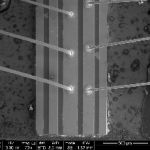EIGHT universities in the UK are to benefit from a £20 million fund to upgrade nuclear magnetic resonance (NMR) spectroscopy. The equipment includes two new 1.0GHz systems (the highest field currently commercially available) plus upgrades to systems with field strengths…
Category: spectroscopy
Terahertz laser reaches 230mW power
Blood analysis from within the plastic bag
AFM infrared spectroscopy boosts resistant bacteria studies
ATOMIC force microscopy (AFM) has been the main analytical tool at the laboratory of physics of living matter at EPFL Switzerland, in the lab’s research into the mechanical properties of proteins, cells, and tissues. Now an Anasys NanoIR AFM-IR system…
Agilent catalogue is ‘user-friendly’
Agilent Technologies has introduced its 2013 Essential Chromatography and Spectroscopy Catalogue. The new volume is divided into five sections to help the reader easily navigate the company’s portfolio, which includes general chromatography, sample preparation, GC and GC/MS, LC and LC/MS,…
Shimadzu University helps improve research methods
SHIMADZU University recently held a series of complimentary ‘Sharing best practice’ events at the company’s Centre of Excellence in Milton Keynes. These were open to any Shimadzu customers interested in learning more about how to get the most reliable results…
Microspectrometer is ‘the future’ of Raman spectroscopy
COMBINING high resolution and high sensitivity with short sampling times and a broad spectral range, the new Artemis Raman microspectrometer from Craic can be deployed on many different types of light microscope. This instrument facilitates the measurement of Raman spectra…
Raman microspectroscope with multiple laser colours
CRAIC Technologies has added further laser wavelengths to its Apollo Raman microspectrometer, with blue, green, red, and infrared now available. Used in conjunction with a light microscope, the Craic Apollo measures Raman spectra from samples or selected areas of large…
Protocol shows way to improved sulphur determination
A PROPRIETARY inductive coupled plasma – optical emission spectroscopy (ICP-OES) sample preparation protocol allowing regular, reproducible detection of sulphur at trace levels of only tens of parts-per-million (ppm) has been developed by Warwick Analytical Service. The company says the new…
Chemical identification at nanometre scale
ELECTRON microscopy and scanning probe microscopy offer the scientific researcher powerful high-resolution imaging at the nanometre scale, but are poor at identifying the chemical composition of the structures they image. Spectroscopy offers powerful chemical identification, but has resolution limited to…


